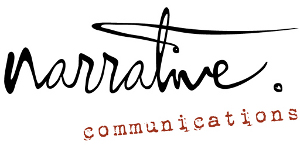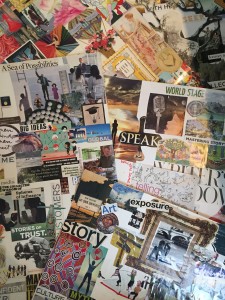Every January, my dear friend Theodora Lamb and I invite a group of entrepreneurial-minded women together to shape the story we want to live in the year ahead. I’ve created a story vision board for the past 9 years (one for every year I’ve been running Narrative Communications!) and it never ceases to amaze me the power that these boards hold.
Theo and I wanted to share the magic we uncovered, and also bring vision boarding to a whole new level by introducing a storytelling component – we call it Story Visioning. We come together to create the story we want to live for the coming year, and we share those stories with others. Storytelling is only one part of it – it’s about giving voice to our dreams, being a listener for others, and holding each other accountable. Most importantly, it’s about celebration – celebrating our stories as a community by recognizing what’s possible when we give weight to our wishes.
So how do we do it? Here’s a simple guide that takes you through our Story Visioning process.
Step 1: Gather Supplies
Gather as many magazines as you can (of all genres) and collect things like greeting cards, photos, or images you feel connected to. You’ll also need scissors, a glue stick and a large poster board.
Step 2: Set Intentions
We use our workshop to get people thinking about their coming year – we work in small groups to talk through questions like “What stories do you want to tell at the end of the year?” and “Name the different components of your life and think about what you want or don’t want in each one”. We then encourage each person to land on ONE WORD that encapsulates what they want 2018 to feel like / bring / offer. This is helpful when crafting your board as it gives you a theme / direction to follow.
- FYI I divide my life into 7 parts and think about each one separately first then as a whole: Family, Career, Marriage, Friendship, Health, Spirituality, Service (charity). Last year, my word was ‘Bright’ and embodied my desire to be more intelligent (learn and read more) as well as to shine brightly! I liked the double meaning of the word and it helped me pick images and words that represented what “Bright” feels like to me.
Step 3: Find Images & Words
Go through magazines, cards, photos and rip out anything that you are drawn to. Don’t worry about making sense of it yet (or deciding if it’s vision board worthy!) – the key is to use your intuition and be impulsive. We often tear out words or images that we don’t understand the meaning behind until we start to craft the board.
Step 4: Choose a Style
There are so many ways to set up a vision board once you have all the pieces you want to use. We give people lots of examples, but ultimately it’s up to you how to set it up in a way that feels good. A few examples to get you thinking:
- A Tree: at the bottom of your board, paste images and words that represent your roots (things that ground you) – move up to Soil (things that nourish you), Trunk (core values), Branches (ways you want to impact the world) and Blue Sky (how you want to feel) and your words and images will follow along this style.
- A Peace Sign: Divide your life into 3 categories: Self / Others / Service. Put images and words on bottom of board that represent things you want for yourself. On the left hand side, put images down that connect to your relationships (friends, family, partner) and on the right hand side, put down images that connect to your service (work, charity, giving back).
- A spiral: Start with your key word at the centre of the board and then spiral out with images and words that represent that word in different ways or areas you want to highlight. This is like a nautilus shell – you start at the core and move outward with your thoughts and wishes.
- Or you can simply cut and paste things haphazardly! There are no rules, just go with what shows up for you at the time. The key is to not overthink it!
Step 5: Paste away!
Once you have torn out your words and images and placed them on your board to see what fits where, start gluing! You can paste things on top of one another, or leave lots of blank space if your intention for the year is to have more room to explore. Either way, just start pasting and don’t worry about it being perfect.
Step 6: Story Telling
The most important part is to share what you have done with someone (or many people!). We call our process Story Visioning as it’s all about creating the story for the year to come. You might not even know why you chose a word or image until you start talking about it with someone, and then suddenly it dawns on you! It’s also key that you put your Story Vision Board somewhere you will see it throughout the year – it can be hidden just for you (I keep my hung on the wall in our office closet!) or it can be visible for others to see.
Step 7: Story Reflection
Finally – we also do a Story Reflection evening every December where we re-gather to share what happened in our year and how our Vision Board supported us throughout the year. We remind ourselves and each other of the stories we set out to create, and then we share what the year truly entailed (highs and lows).
Theo and I will be hosting our yearly Story Visioning in January. Reach out if you want to learn more!

